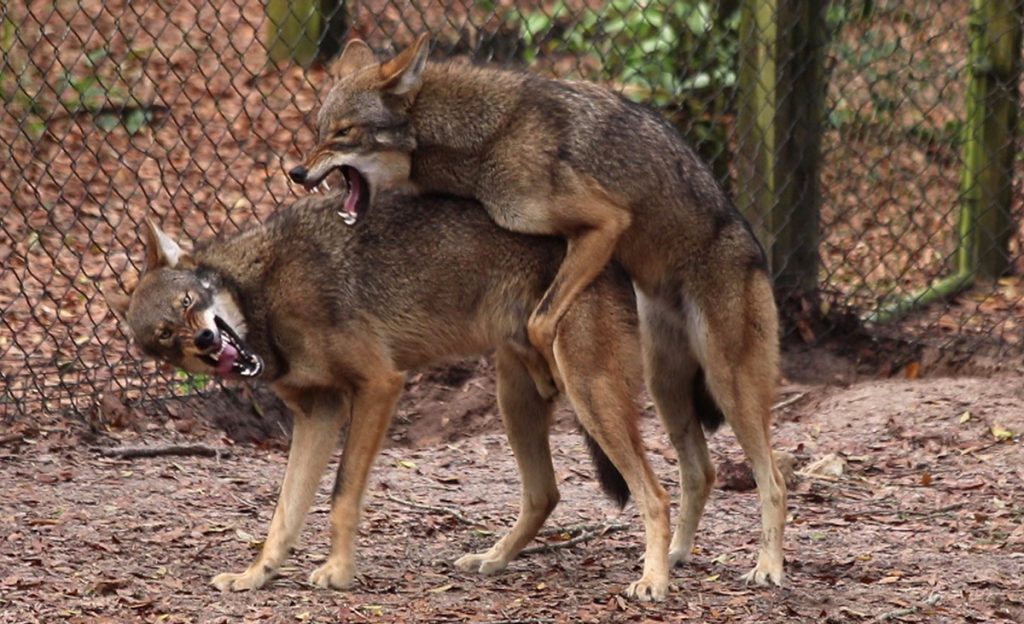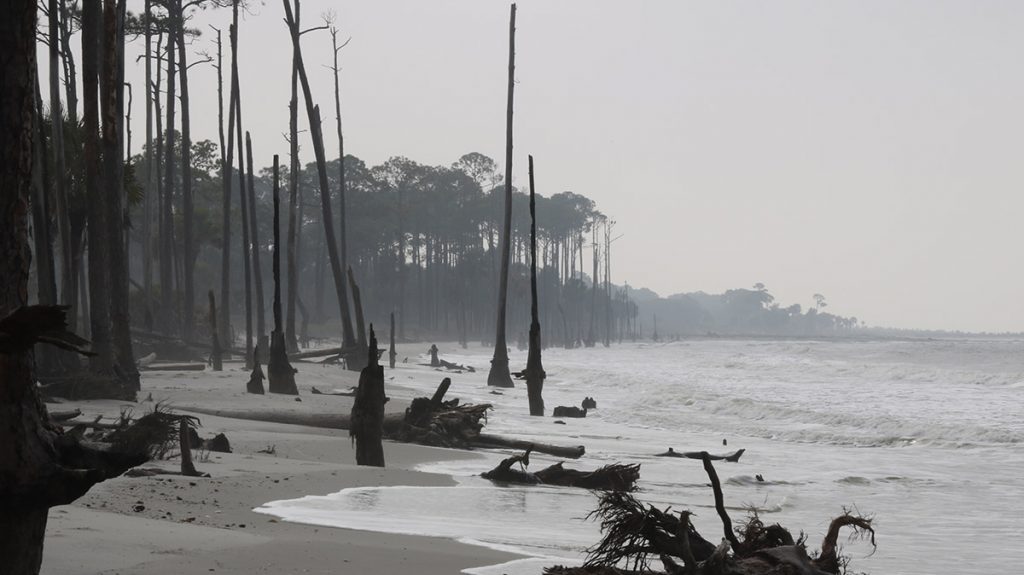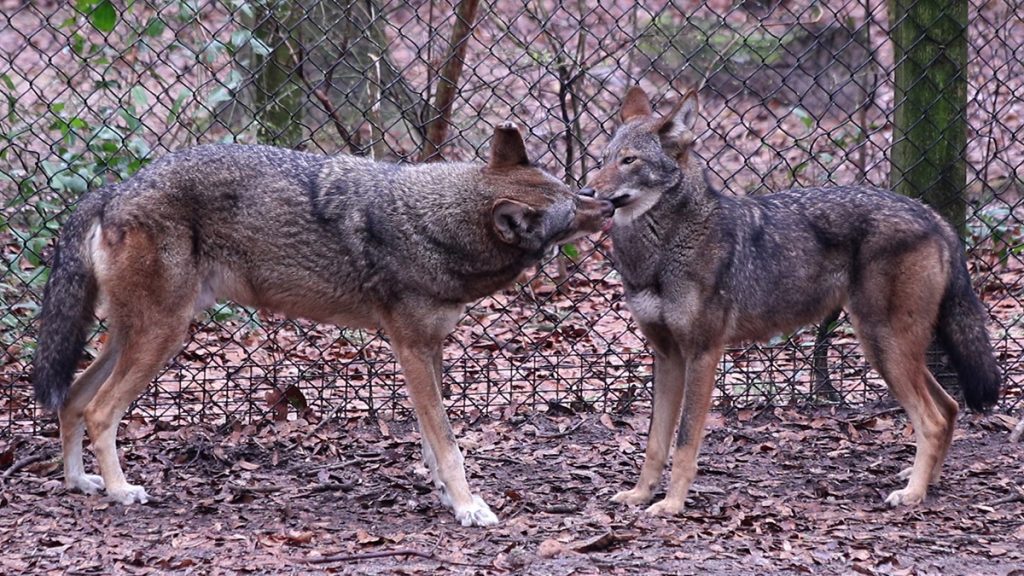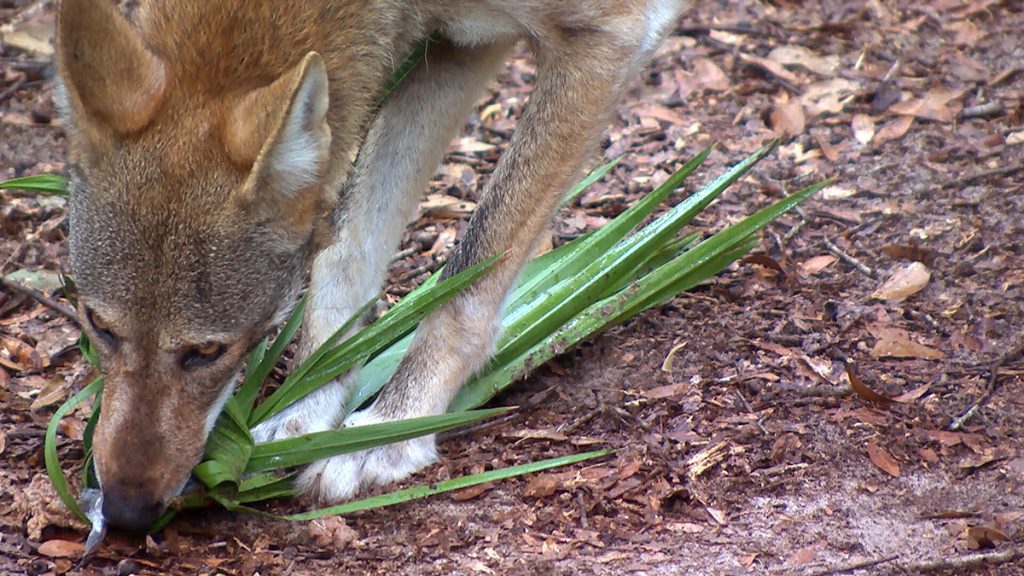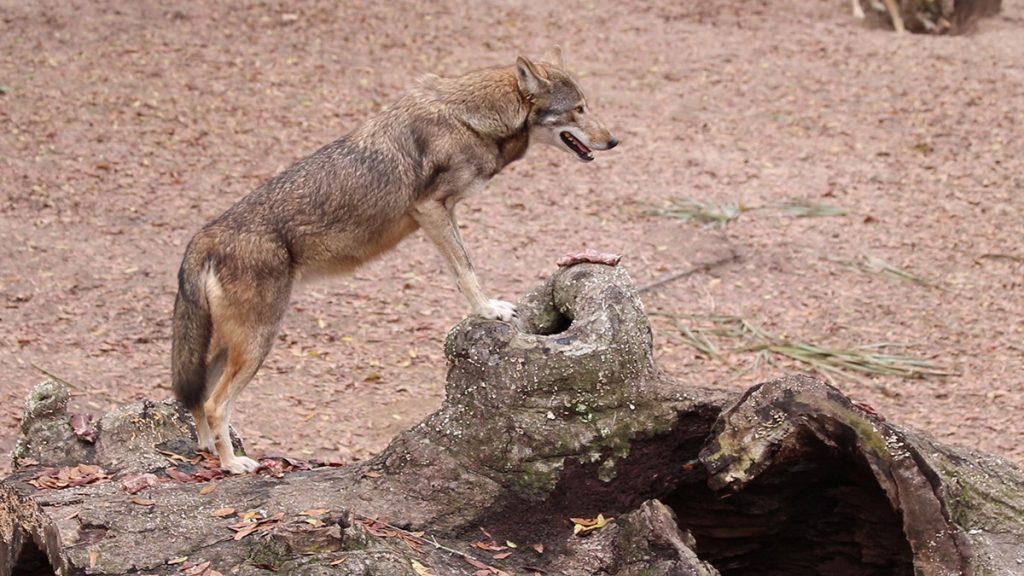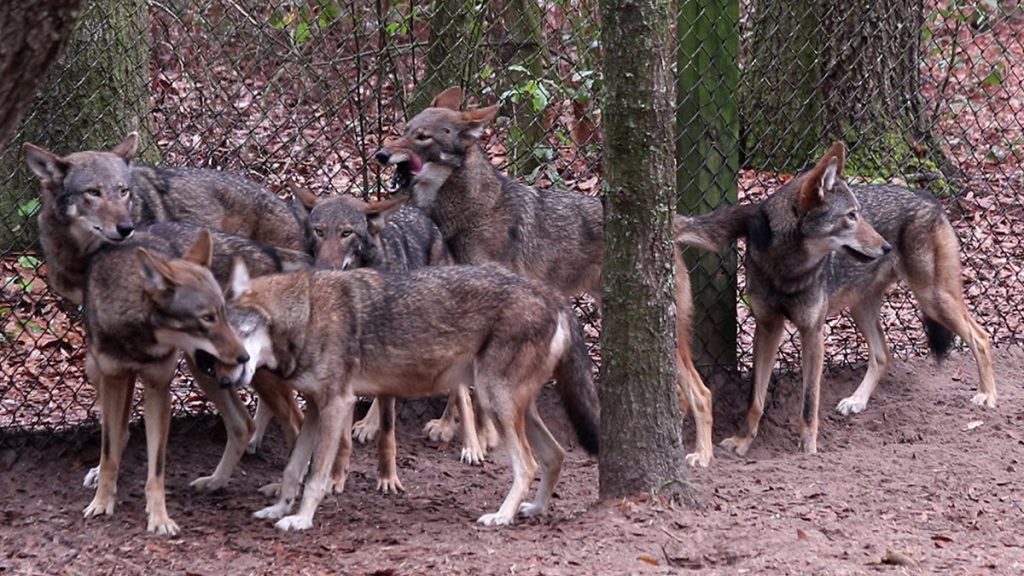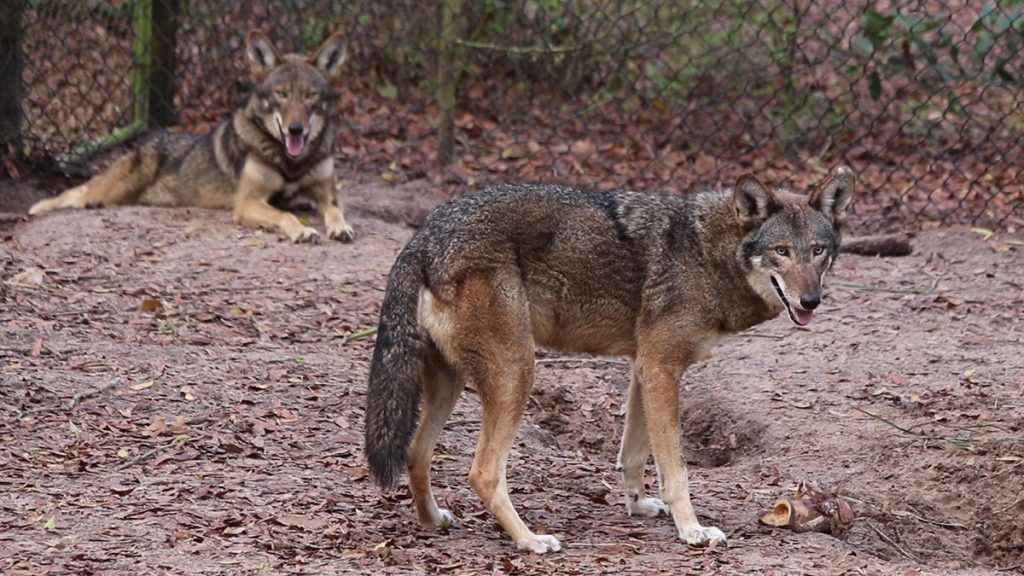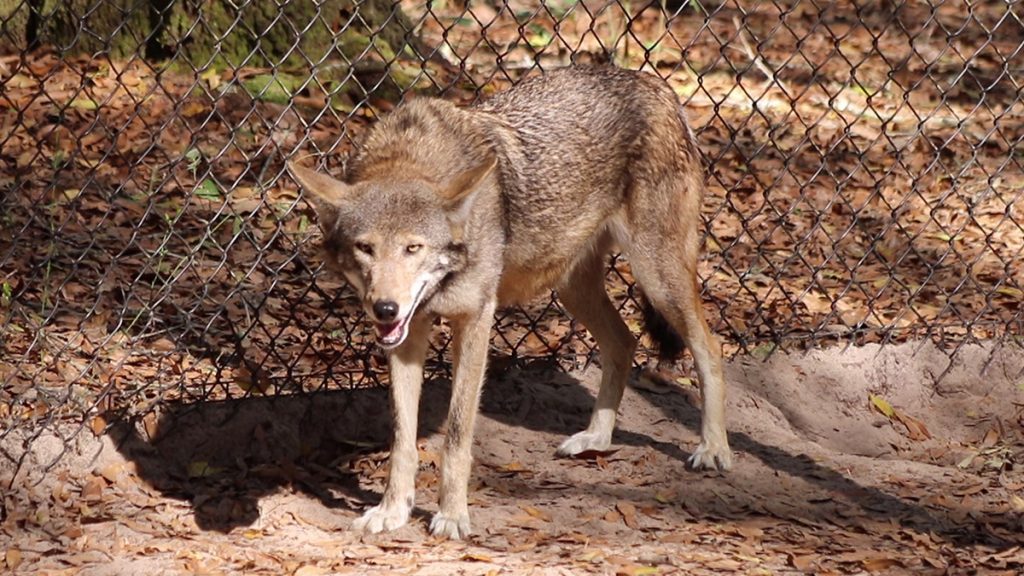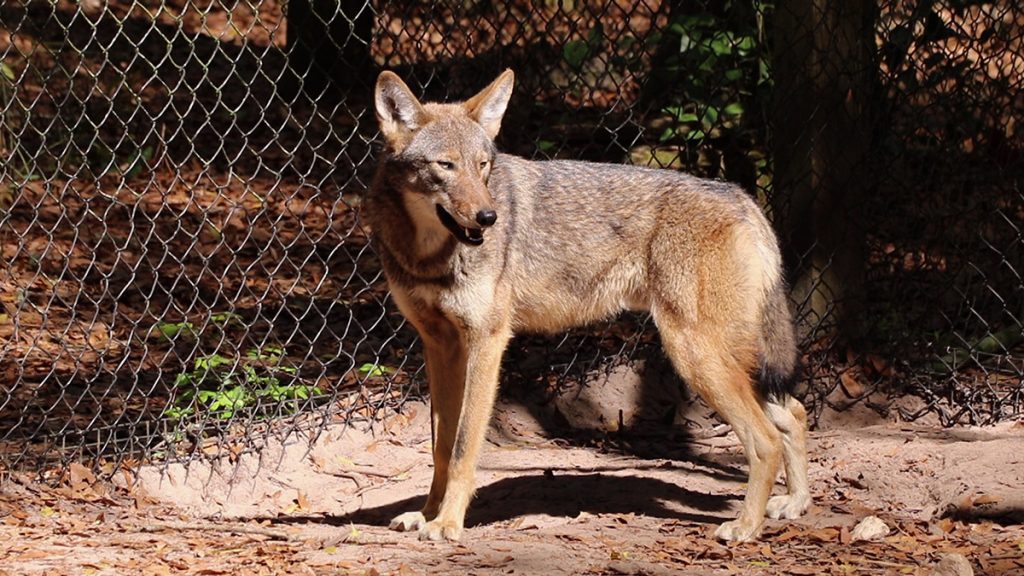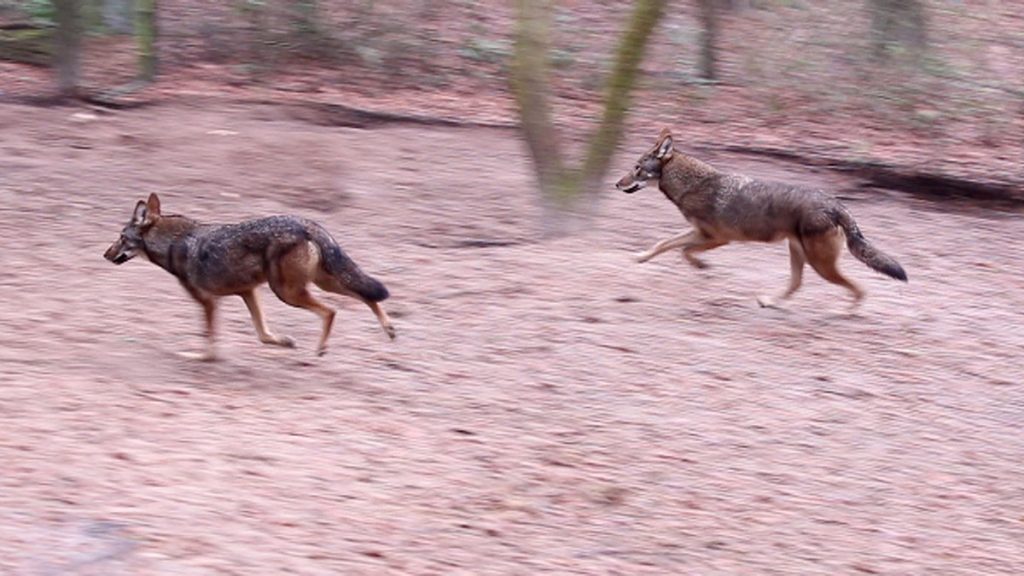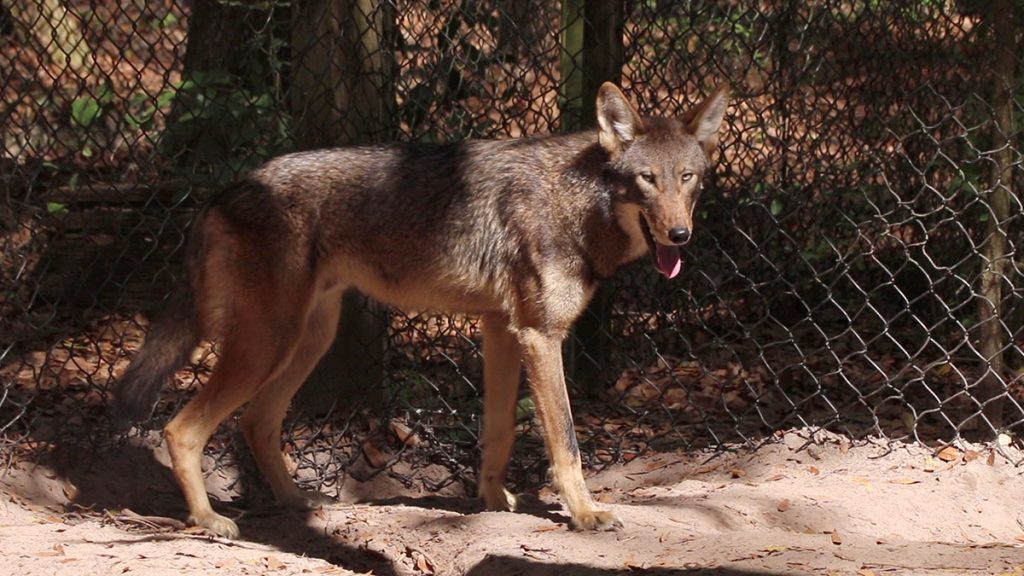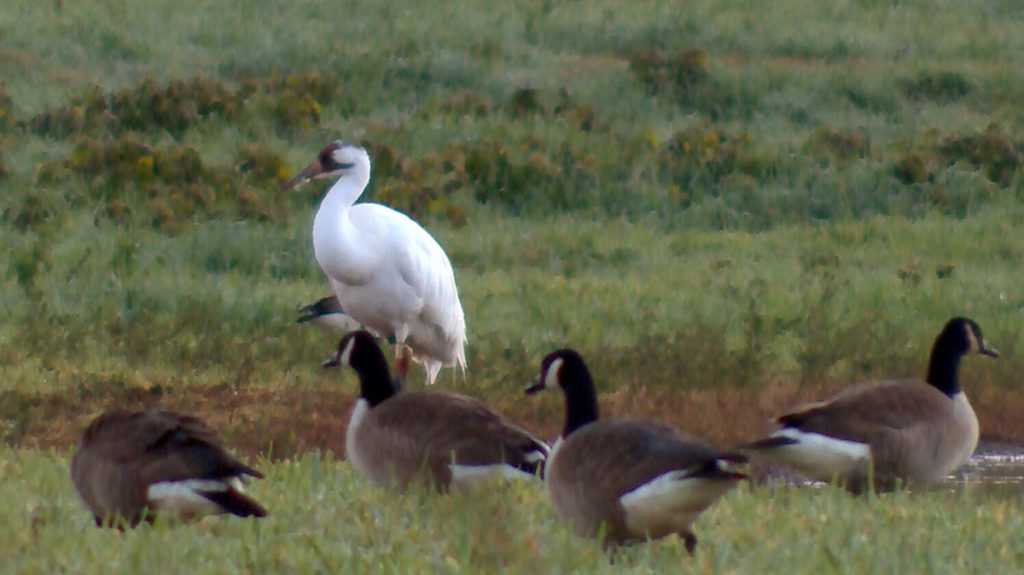The Tallahassee Museum’s red wolf pups are shy, and especially early on, few people were able to see them. Luckily, they became accustomed to our cameras, and so we’ve been able to watch them grow. Below is a documentary on their first year.
Some days, the red wolves are more obviously “wild” than others. One day, for instance, I got footage of two pups fighting over a bone. Just as soon as the short tailed alpha puppy asserted that it was his rib, he became alert. I could hear a police siren faintly in the distance. Soon, all eight of the Tallahassee Museum wolves were howling. It sounded more monkey than wolf-like to me, a combination of longer howls and strange whoops. It was everything I could ask for out of a shoot day.
That was in February of this year, after I’d been visiting the Museum’s red wolf family for several months. Early on, I was ecstatic when the pups would scamper out for ten minutes. On some frustrating days, they’d avoid me altogether. Interviewing the animal staff for the documentary above gave me a new perspective on the wolves’ shyness. Mistrust of humans is as wild a behavior as howling or fighting over food.
I have to thank the Tallahassee Museum for the access they gave me to the pups, starting when they were just shy of two months old. The exhibit had been partially closed after the staff noticed how much the parents were bothered by people. Mom and dad didn’t particularly like the staff, and kept the pups hidden deep in a den.
I was given permission to go into the closed part of the exhibit, but no one guaranteed that I’d see anything. I waited for hours, recording a lot of white squirrel footage. When that first little head poked out of the den, they had me hooked. I wanted to see them grown up on camera. Months later, this is the show I’m proud to share with you.
Tallahassee Museum Red Wolf Pups | Valuable Genetic Assets
You might think, What lousy zoo animals. They don’t even come out for people! And that’s one way to look at it. “The pups were a huge draw early on,” says Shelby Bush, the Museum’s lead animal handler. “Unfortunately they did hide a lot. Mom and dad did keep them fairly wild-acting, which is good for the family. Not so good for the public. So we did have some upset about that.”
After a couple of months, the staff filled in their den and the pups moved inside the house. There, the staff has a camera to monitor them. So animal handler Laura Augustine was able to show visitors what they were doing right on her phone. Like the other animals at the Tallahassee Museum, the wolves are here to educate the public about the animals that live (or used to live) in our local wild spaces. Unlike the other animals, they had once been declared extinct in the wild. And with the wild release of red wolves on hold, there’s a threat that the species might become strictly a captive population.
As we covered in a couple of segments last year, the wolves are part of what animal curator Mike Jones calls “the most successful predator recovery and reintroduction of any carnivore in the world.” Having virtually disappeared from a range that ran from Texas to Pennsylvania by the 1970s, US Fish and Wildlife biologists rounded up as many individuals as they could find. They found fourteen that they deemed would make a good genetic bedrock from which to rebuild the species.
That makes every individual red wolf genetically valuable. They may not have put on a show in their smaller, cuter days. But that wasn’t their primary goal. They’re supposed to grow up, breed, and keep the species going.

Tallahassee Museum animal handler Laura Augustine holds a one week old red wolf puppy during a checkup. These checkups and the camera in the puppy’s house were all the staff saw of them for a few months. Photo courtesy Tallahassee Museum.
Maintaining Genetic Diversity in the Red Wolf
You might think what I thought when I first learned it: fourteen animals is not a lot of individuals from which to start a breeding program. As we covered earlier on, the participants in the Red Wolf Recovery Program use what is known as a Mean Kinship test to find the least related, least genetically represented wolves to pair together to breed.
Every individual has a score. And as wolves become parents, the score changes. As assistant animal curator Suzie Buzzo tells us, since this is mom’s second litter, she now has a lower score. “She’s pretty well represented, since she’s had two litters. And so they didn’t necessarily want to put these two together again.”
And that last line hints at another reality for wolves in this program- in pursuit of the best matches every year, they’re always on the move. The dad has a higher score, and so either he or the female could find themselves somewhere else next year. Likewise, the pups are genetic assets, and so this family may not have a lot of time together.
That’ll be decided in July, when members of the Red Wolf Recovery Program meet. However, the wolves might have limited destination options.
“We’re running up against limited holding space,” Mike Jones says. Red wolf breeding capacities are at capacity. Before we look at the reason why, let’s get an overview of the system.
Red Wolf Recovery Program | A Quick Overview
The Tallahassee Museum is one of 40+ zoos that breed red wolves. Captive breeding has its advantages. For one thing, zoologists can better control breeding behavior. Right now, the Tallahassee Museum’s female is implanted with a contraceptive that will dissolve by next breeding season. So they won’t have new pups this year.
Additionally, staff can observe wolves and (relatively) easily give them vaccines and medical care.
But the end goal of the Recovery Program is to establish a wild population. And while every effort is made to keep the wolves wild in captivity, they don’t have to hunt for their food. And they don’t have to figure out what to do with their pups when a hurricane comes.
That’s why the US Fish and Wildlife Service established Island Propagation sites. An island gives a wolf a confined area to roam, and an area away from people’s homes. Here, wolves can transition to wild living.
We have one such site in our area, at the Saint Vincent National Wildlife Refuge.
Captive wolves are brought to an acclimation pen, where they transition to the foods they’ll hunt.
“And once they’re eating that well,” Mike Jones says, “they release them on the island, and they learn how to hunt and be wild wolves. And when they have pups out there, they’re raised by the parents, so they’re raised in the wild.”
Last year, we visited the island with former red wolf volunteer Robin Vroegop. There, she told us what one of the mothering legends of the red wolf breeding program did with her pups when Hurricane Dennis devastated the island.
Into the Wild at Alligator River
The Saint Vincent wolves are wild, but they’re just one family. And isolated families can’t become a self-sustaining population. Until recently, it looked like the US Fish and Wildlife Service was able to achieve just that at their wild release site at two National Wildlife Refuges in North Carolina- Alligator River and Pocosin Lakes.
“The program did really, really well out there,” Says Suzie Buzzo. “I think it went from a hundred releases, and it was a very sustainable population at two-twenty-five for some time.”
The population has dwindled from that peak of 130 to fewer than 50 today.
“They had some coyotes slipping into the population and allowed the local people to hunt those coyotes,” Mike Jones tells us. “And they started shooting red wolves by accident, and so they had to stop that program.”
Right now, the future of the program is up in the air. For decades, breeding facilities and Island Propagation sites had funneled wolves to North Carolina. Some, like the Tallahassee Museum’s breeding female, cycled back into breeding facilities in the interest of creating the best genetic matches.
Now, the system is at capacity. Mike Jones mentioned to me that some zoos have multigenerational packs with grandparent wolves. Lacking a wild release option, could such a pack become a reality at the Tallahassee Museum?
Were the Red Wolf Shootings Accidental?
Added April 14, 2018
Let’s take a moment and take a closer look at what happened to the red wolves in North Carolina. Red wolves were not universally welcomed by residents of the land adjacent to the Wildlife Refuges where the wolves had been released. And so there is some debate about the intentionality of the red wolf shootings, and why the US Fish and Wildlife Service decided to halt wild releases on the Albermarle Peninsula.
The following is a statement from the Red Wolf Coalition which sheds a different light on the matter:
“The incursion of coyotes onto the Albemarle Peninsula in northeastern NC (the 1.7-million acre red wolf recovery region comprised of both public and private land) was not the main cause of the wild red wolf population crash starting in 2010. Established red wolf packs kept the coyotes in check, and field biologists had an excellent adaptive management plan in place to sterilize resident coyotes on the western edges of the recovery region.
“The two reasons for the precipitous decline were illegal and deliberate gunshot mortality (not accidental) and the failure of the U.S. Fish and Wildlife Service administrators in Atlanta to continue fulfilling the agency’s responsibilities to recover the red wolf under the ESA (the subject of the ongoing lawsuit by the Southern Environmental Law Center – SELC – on behalf of the Red Wolf Coalition and 2 others). Because of another lawsuit won by SELC on behalf of the Red Wolf Coalition, Defenders, and AWI, coyote hunting in the 5 counties of the Albemarle is illegal except by specific permit. Thus, mistaken identity is not a factor.”
Red Wolf Breeding Season
We mention in the documentary that red wolves have started digging dens again, even though the mom has not bred. Seasonally, however, this is about the time pups are born every year.
Shelby Bush explains:
“Red wolves are a little bit different than dogs. We’re used to dogs and cats going into heat multiple times if they don’t get bred. But red wolves are strictly once a year. And it kind of depends on where you are in the country for temperatures, but around here they mate generally January/ February, so our pups were born mid-April.”
Last Valentines day, the Tallahassee Museum held its usual romantic, adults only night out. Visitors witnessed mom and dad breeding, and reported it to the Museum staff. The pups were born on April 21.
And by the way, the staff loves it when you share information about their animals with them. That’s how they knew mom might be pregnant, and it’s also how the staff was once able to save a breeding male from violent encounter with a breeding female. After all, they only have so many eyes and so many cameras.
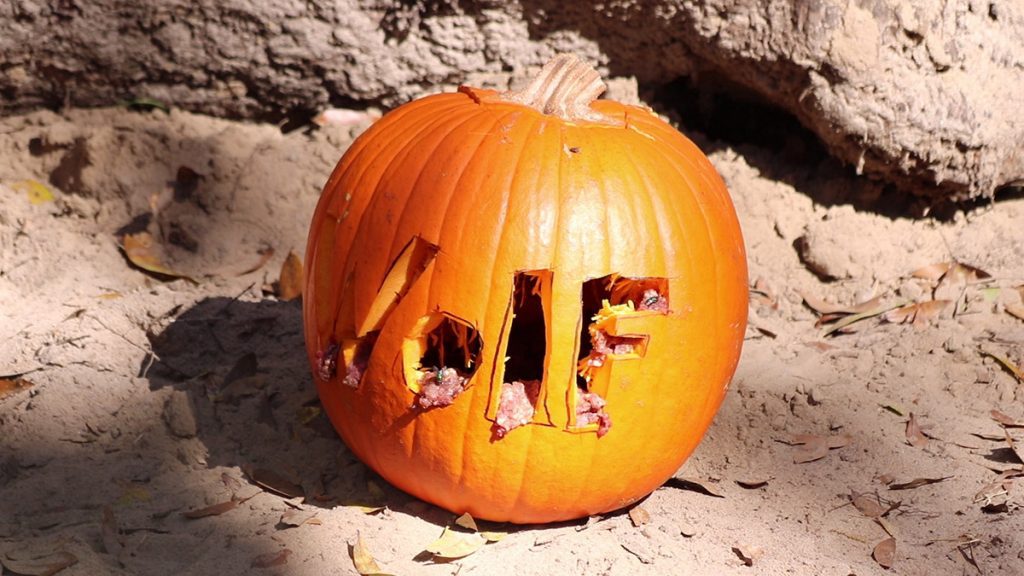
Tallahassee Museum animal handler Laura Augustine carved two pumpkins and filled them with venison to celebrate the pups’ first birthday.
Environmental Enrichment
Quite a lot of our show deals with environmental enrichment. I think that might be what surprised me most as I followed the pups- how much goes into stimulating the wolves’ wild instincts.
This included a variety of urine sprays, representing prey and rival predator species. They’d also mix up their snacks and toys, and other objects for them to play with. After Christmas, you may notice trees in many of the exhibits.
The pumpkins you see at the beginning of the show had been on our porch since Halloween. An uncarved pumpkin takes forever to rot, but by February my wife wanted them gone. Mentioning them to Laura Augustine, she offered to make them into a birthday treat for the pups.
“Yeah, it’s definitely my favorite part of the job,” She says, “Because you get to be so creative. You know, you try to put it together in a way that they haven’t seen it before.”
Here’s another treat the staff created:
Says Suzie Buzzo: “If one of our bobcats or panthers pees on something, like on a piece of cardboard, we can put that in [the wolf exhibit]. I think they did that yesterday, gave them something that one of the panthers peed on. And that’s a whole new thing. Because that’s introducing smells they’d actually be experiencing in the wild. And then they rip it up, and they have to pee on it.”
And then of course there’s this log, found by Shelby Bush. They can climb into or on top of it, and sometimes find a meaty treat:
Meet the Pups & Parents
At almost a year old, the pups are mostly full grown. When the family gathers together and starts piling on, as in the photo above, they can be hard to tell apart. A good place to start are the legs- the pups’ legs are still pretty skinny compared to their parents.
Dad- Leader of the Pack
Dad is the biggest. As of my last visit, he’s still the tallest and thickest. As Laura says, he’s a “big, perfect wolf.” But with each passing week, those pups are getting bigger…
Mom
Mom is also more filled out than the pups, even if one or two appear to have gotten taller. As Laura describes in the video, she’s often hunched. Twice in the show, you can see how she hunches lower when visitors on the boardwalk get loud.
Alpha Puppy
If you visit first thing in the morning, and are quiet, you may see multiple puppies. Most of the time, though, the only wolves out are mom, dad, and the one Laura calls “the brave puppy.” He’s the alpha pup, distinguished by his short tail. Later in the program, you can see how another pup gets a little too close while he’s enjoying a horse rib, and he asserts his dominance.
Girl Pup
The litter’s lone female is easy to identify- she’s the darkest. She’s also slightly smaller than the male pups.
Crook-tailed Pup
One of the other two males has a crook in his tail (that’s him on the right). After the short-tailed pup, he’s the puppy I notice out of the house most.
Shy Guy
We can call this guy “process of elimination” puppy. His tail is neither short or crooked, and he’s not as dark as the female. As the pup in this image lacks any single, obvious trait to make him stand out, this must be the shy pup. He’s the pup you’re least likely to see, and when they’re all out, the most likely to run back to the house if there’s a loud sound or other stimuli.
We’ve covered other endangered species…
Following the pups has been a valuable experience, as it gives us a glimpse of what’s missing in our local ecosystems- our apex predator.
While we are surrounded by a considerable acreage of protected land in north Florida, human activity pushes an increasing number of other species closer to extinction. Some animals, like the red wolf, were hunted to the brink. Others are falling victim to habitat loss and climate change.
However, like we see in the video, there are people who are tirelessly working to restore or preserve species. We’ve covered a few in our area. Like with the red wolves, each recovery effort requires cooperation between multiple partners. Some have had setbacks similar to the Red Wolf Recovery Program, that send the programs in new directions. The thing they all have in common are the folks who dedicate their time- often quite a lot of it- to a particular animal or animals.
Whooping Crane Grus americana
A few years ago, we trekked into a remote marshland within the St. Marks National Wildlife Refuge. Here, we visited a fenced in enclosure where Operation Migration had led several whooping cranes to overwinter. Whooping cranes had once been reduced to just over 20 individuals in the 1940s. Their numbers have since rebounded, with about 600 cranes migrating between Canada and Texas every year.
But that’s a single population- if any sort of disaster threatened the population or the specific areas where they live, the species would be vulnerable. That’s why a consortium of government and nonprofit organizations teamed up to establish the Eastern Migratory Population, starting in 2001.
This second migratory group of whooping cranes is based at the Necedah National Wildlife Refuge in Wisconsin. They were captive bred and raised by humans in crane costumes. Then, ultralight planes led them to their wintering grounds at two National Wildlife Refuges in Florida.
After their first guided flight, adult cranes were able to make the migration themselves, which was considered a success. However, the birds were not able to successfully breed and raise young in the wild. The US Fish and Wildlife Service determined that the methods used to raise the cranes were too artificial, and inhibited their instincts. In 2016, they ended ultralight guided migration.
Currently, these cranes are bred in captivity and released near adult cranes that have lost a chick, or have an empty nest. The hope is that these cranes will raise the young ones more naturally than a costumed handler.
Red Cockaded Woodpecker Leuconotopicus borealis
As part of our Roaming the Red Hills series, we were able to watch an endangered seven day old red cockaded woodpecker get banded. We were at Tall Timbers Research Station and Land Conservancy with biologist Jim Cox.
While red wolves and whooping cranes were hunted to near extinction, the red cockaded woodpecker is endangered due to habitat loss. Massive clearcutting reduced the RCW’s preferred habitat- longleaf pine forest- from 90 million to 3 million acres. What’s more, much of the 3 million acres was planted within the last few decades, and the RCW needs trees 90 years or older to make nesting cavities.
Biologists have done a good job of raising their numbers using artificial nests. You can see the rectangular shape around the cavity above. But while numbers are better, until the red cockaded woodpecker can survive without human help, they can’t sustain their current numbers. And so they remain endangered.
Striped Newt Notophthalmus perstriatus
So far we’ve seen animals endangered through hunting and habitat loss. The striped newt is a victim of prolonged drought.
This animal lives in ephemeral wetlands, which fill and empty as the underlying water table rises and falls. The water table is in turn affected by seasonal wet and dry periods. When its wetland dries, this animal morphs and goes into the pine uplands. It’s adapted to these dry stretches.
However, the earth’s warming climate exacerbates droughts, and, starting in the 1990s, ephemeral wetlands in the Apalachicola National Forest stayed dry for ten years. By the time wetlands filled again, the striped newt went extinct there (or extirpated, which is when an animal goes extinct in a given place).
As we’ve been covering over the last couple of years, the Coastal Plains Institute has been leading an effort to restore stripe newts to the Munson Sandhills region of the forest. Using newts bred at the Jacksonville Zoo, they’ve been reintroducing the species. And they’ve been seeing evidence that their released newts are breeding.
Currently, the wetlands are dry. And periodic dry spells are normal. My family and I recently visited the striped newt repatriation ponds with CPI’s Rebecca Means. While we didn’t see newts, we did see plenty of spring flora and fauna. Look for a blog post next week.

